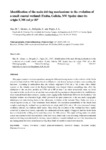Identification of the main driving mechanisms in the evolution of a small coastal wetland (Traba, Galicia, NW Spain) since its origin 5700 cal yr BP

Use este enlace para citar
http://hdl.handle.net/2183/18269Colecciones
- GI-GRICA - Artigos [49]
Metadatos
Mostrar el registro completo del ítemTítulo
Identification of the main driving mechanisms in the evolution of a small coastal wetland (Traba, Galicia, NW Spain) since its origin 5700 cal yr BPFecha
2007Cita bibliográfica
Bao, R., Alonso, A., Delgado, C., Pagés, J.L., 2007. Identification of the main driving mechanisms in the evolution of a small coastal wetland (Traba, Galicia, NW Spain) since its origin 5700 cal yr BP. Palaeogeography, Palaeoclimatology, Palaeoecology 247, 296-312. http://dx.doi.org/10.1016/j.palaeo.2006.10.019
Resumen
This paper examines the interdependence among the different forcing factors in the evolution of the Traba coastal wetland (Galicia, NW Spain) based on lithofacies and diatom analyses of three cores reaching the basement. According to radiocarbon data, the wetland originated 5700 cal yr BP, a time when similar systems on the Atlantic coast of the Iberian Peninsula were formed. Diatom assemblage data allow the estimation of the sea level position at 5700 cal yr BP at least 7 m below present-day mean sea level. Attenuation of the sea-level rise at that time was a major driving mechanism that permitted the establishment of an incipient beach–dune complex, causing water-logging in the Traba basin. However, the location of this incipient wetland on a basement high, which prevented an open connection to the sea, made topographic inheritance the main forcing factor in the subsequent evolution of the wetland. Thus, Traba was never a coastal lagoon system, as it has sometimes been defined. The maximum permeability of the beach–dune complex enclosing the wetland was recorded after its origin until 2900 cal yr BP, when increased stormy conditions affected the Galician shelf waters. Since then, the evolution of the wetland has been mainly controlled by more local factors, especially the continental sediment supply. Changes in land use in the basin have accelerated the infilling of the water body since the 19th century. This rapid infilling makes the whole system more prone to total encroachment in the short term, rather than to sea drowning. Palaeoenvironmental analyses showing the main trends in the long-term evolution of coastal wetlands can be of key importance in any management decisions aimed at preserving these kinds of sensitive coastal environments.
Palabras clave
Coastal evolution
Coastal palaeoenvironments
Sea-level change
Sediment supply
Diatoms
Holocene
Coastal palaeoenvironments
Sea-level change
Sediment supply
Diatoms
Holocene
Versión del editor
ISSN
0031-0182





